Menus
- Top test: Suzuki V-Strom 650 ABS
- Suzuki’s 650 V2 pedigree
- MOTORRAD conclusion
- Technical data V-Strom

Bilski
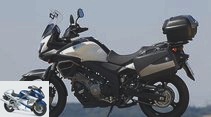
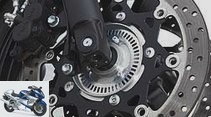
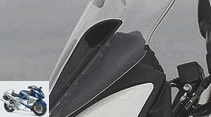
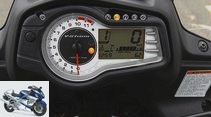
13 photos
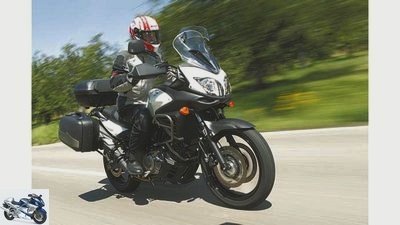
Bilski
1/13
Not just nicely styled. In touring trim, the handy Suzuki V-Strom seduces you to brisk hustle and bustle on winding streets…
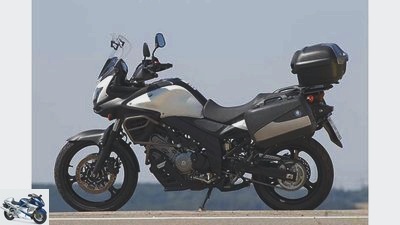
Bilski
2/13
V-Strom: Suzuki’s successful mid-range all-rounder had to show what it can do in the MOTORRAD top test.
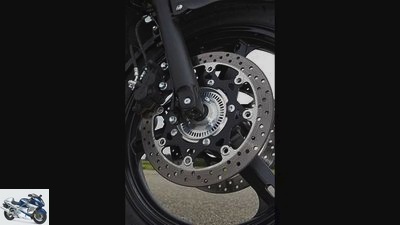
Bilski
3/13
The new ABS controls much more confidently, the double-piston brake decelerates very well.
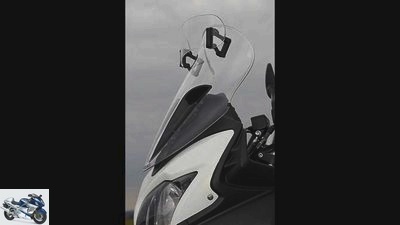
Bilski
4/13
Provides wind protection that is free of roar and turbulence: the accessory touring screen.
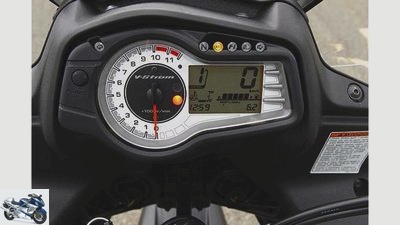
Bilski
5/13
More modern: the new cockpit with gear and consumption display.
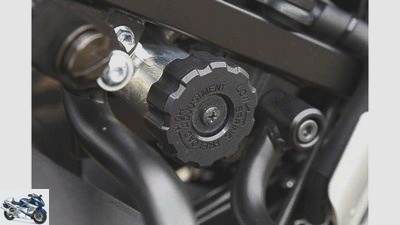
Bilski
6/13
Practical: the spring strut can be pretensioned using an easily accessible handwheel.
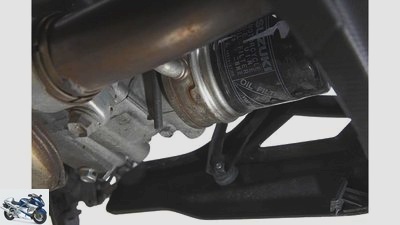
Bilski
7/13
Cooler: Instead of an oil cooler, there is now an oil filter surrounded by cooling water.
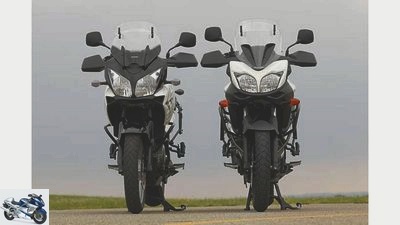
Bilski
8/13
Mirror Mirror …

Bilski
9/13
… who is the prettiest V-Strom? The old one (left) looks bulkier, more angular, the new one more filigree despite the identical chassis. The engine was tilted forward three degrees.
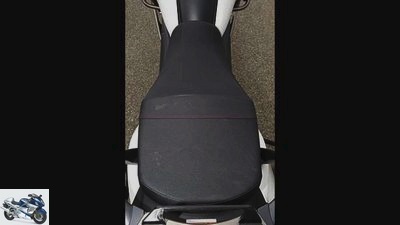
Bilski
10/13
Plus: The newly designed bench with a better contoured shape and softer upholstery is not only flattering on the buttocks, but also on the eye thanks to the high-quality decorative stitching. The passenger can now hold on to the new pillion grab bar in a more relaxed and pain-free manner thanks to the more convenient shape and rounded edges.
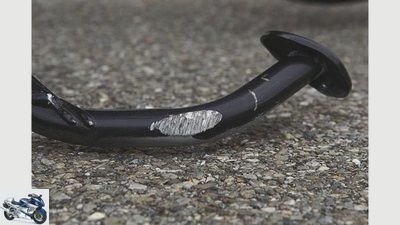
Bilski
11/13
The boom of the accessory main stand comes into contact with a sporty driving style in an easily reachable incline, as the clear grinding marks show.
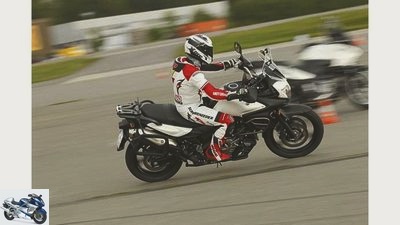
Bilski
12/13
Even good is even better. Suzuki proves this with the new V-Strom. The revised, unchanged economical V2 makes the 650s even more energetic, the less angular design looks more pleasing. Handiness and driving stability are at the highest level.
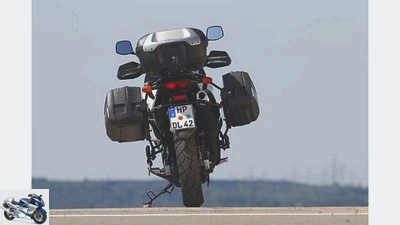
Bilski
13/13
Conclusion: Thanks to only moderate price increases, future success should be assured.
Suzuki’s new all-purpose weapon put to the test
Top test: Suzuki V-Strom 650 ABS
Numerous changes should turn the Suzuki V-Strom, model year 2012, into a freshly styled, even better all-rounder. How successful is the model change?
Bilski
Suzuki’s successful mid-range all-rounder cuts a fine figure with its new, significantly rounder styling, even with full touring equipment.
Electricity usually has something to do with voltage. So far, however, very few people have found the V-Strom really exciting, although almost all had to admit that Suzuki has put a successful, very versatile all-rounder on the wheels with the 650er. It is not for nothing that V-Strom won the overall victory in the great MOTORRAD Alpine Masters in 2005. Engine, chassis, comfort – the Suzuki rightly earned praise everywhere. The coarse, angular styling remained controversial to this day. Among other things, Suzuki wants to remedy the situation for the 2012 model year.
Buy complete article
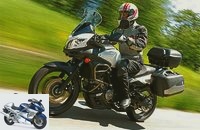
Suzuki’s new all-purpose weapon put to the test
Top test: Suzuki V-Strom 650 ABS
Bilski, Jacek
The Suzuki V-Strom follows exactly the line chosen by the driver.
In the redesigned, more modern cockpit, the value can even be read from the fairly accurate consumption displays for the two trip meters. There is also information about the outside temperature, a fuel gauge is on board, and Suzuki has even given the new one a gear indicator. The pilot does not need to worry about the tank capacity, which has dropped from 22 to 20 liters: In terms of figures, an enormous range of over 500 kilometers is still possible with a cautious driving style. Such stages, the pilot and the passenger, who are also enthroned on a well-padded and neatly dimensioned place, sit on one cheek, so to speak. Nothing pinches, nothing pinches, the improved wind protection also pays off on long stretches of the motorway: the window, which can be adjusted to three positions (standard, 24 millimeters higher or 18 lower), has moved a little closer to the driver. The fact that four screws have to be loosened to adjust and the adjustment is not carried out electrically at the push of a button is certainly due to the cost pressure and is easy to get over. Even in the standard position, the mounted accessory touring screen provides adequate protection from the wind and flows discreetly around the driver’s helmet without causing annoying booming noises or turbulence.
If you are in a hurry and just want to heat quickly from A to B, you can safely step on the gas thanks to the stability of the chassis. Even at full throttle, the V-Strom is quite stable, a deliberately initiated stirring never sways dangerously, the 650 is alien to real oscillation. The promised top speed, increased by five to 185 km / h, proves to be credible. The old V-Strom can barely stay in the slipstream at full throttle, the new one clearly pulls away and swings up with a little acceleration up to speedometer 200 at just over 9000 / min, thanks to the long-translated sixth (slow) gear it is still far away from the red area. The suitability for travel could therefore be preserved, even slightly improved. What about the handiness and chassis quality of the former Alpine Queen? The fork, which can only be adjusted in preload, and the shock absorber, which can be adjusted in preload and rebound damping, provide a solid compromise suitable for everyday use.
The standard setup is sufficient in everyday life, the fork responds sensitively, does not hit through rough heels or harsh braking maneuvers, the shock absorber can cope with a rider even on the bumpiest section of the extended test lap without any loss of driving stability. A direct comparison in terms of handiness, accuracy and neutrality is a real aha experience. If the old V-Strom was already considered an extremely virtuous and uncomplicated bike in this regard, the new 2012 model even tops it. The new one steers extremely precisely, remains steadfastly on course in curves and amazes with a handiness, as if it was rolling on the front of a 17-inch model instead of the 19-inch model, which is still standard. This light-footedness may also be attributed to the production tire Bridgestone Trail Wing, which obviously works brilliantly (old model on Bridgestone Battle Wing), here the right decision was made in terms of tire choice.
Bilski, Jacek
Camouflage and deceive: Even in touring trim, the handy V-Strom tempts you to brisk hustle and bustle on winding streets.
The Japanese also made a good choice by using the new ABS from Bosch, which weighs 0.7 kilograms and is only half as heavy. The faster and more sensitive regulation of the brake pressure pays off with a much more stable braking behavior. The braking effect is kept at a constantly high level, without the rough locking phases and rough build-up and decrease of the brake pressure, as can be seen with the predecessor. Small weight savings such as with ABS and the smaller tank volume lead to a reduction in total weight of three kilograms, as promised by Suzuki, and even four kilograms measured in the test (with identical additional equipment).
The extensive special equipment of the V-Strom allows the MOTORRAD scales to display an impressive 232 (factory specification with full tank: 214) kilograms and the payload to shrink to a rather modest 183 kilograms. Not a broken leg and hardly an obstacle for the presumably numerous V-Strom buyers in the future. In any case, the dealers are eagerly awaiting interest from customers.
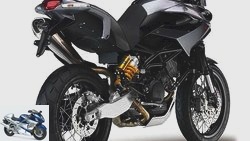
Tourer
Benelli, Buell, Moto Guzzi and Moto Morini
Comparison test of travel enduros
read more
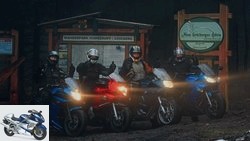
Tourer
Comparison test: faired mid-size motorcycles
Four mid-range bikes with full fairing in comparison
read more
Suzuki’s 650 V2 pedigree
Manufacturer
A stroke of luck: The V2, which made its debut in the SV 650 in 1999, looked well-engineered from the start, proved to be reliable and managed to convince as a drive for various bike concepts. Sports fans appreciate pulling power and revving, touring riders appreciate its running culture and economy. Various improvements in the course of the construction period culminate in the current evolutionary stage in the V-Strom, model year 2012: With a measured 71 PS, the current V2 is good in the feed.
Manufacturer
1999: The strong character, powerful, throbbing short-stroke (still without exhaust gas cleaning and with 39er Mikuni carburettors) provides the SV 650 with surprising performance and amazes the competition.
Manufacturer
2003: Increasingly stricter emission regulations require the V2 to be equipped with injection and U-Kat. Nothing changes in the output of 71 hp, but the engine is now also used in the new V-Strom 650 travel enduro. The V2, which was initially black, has been in silver since 2001.
Manufacturer
2007: Changes to the engine management and a G-Kat make the V2 now meet the Euro 3 standard. In addition, the two-cylinder mutates into a double igniter, i.e. two spark plugs per cylinder provide the necessary ignition sparks.
2008: The SV disappears from the program, but the V2 receives modified piston rings for use in the V-Strom. The alternator and regulator are also modified.
Manufacturer
2009: For the SV successor Gladius, the V2 is being turned inside out and trimmed for torque: crankshaft with more flywheel mass, lighter valves and springs, modified camshafts, new injection with double throttle valves.
2010: At the "old" V-Strom-V2, crankshaft bearings and alternator are changed.
Manufacturer
2012: The new V-Strom has the Gladius engine, but tuned to 69 instead of 72 hp.
MOTORRAD conclusion
Even good is even better. Suzuki proves this with the new V-Strom. The revised, unchanged economical V2 makes the 650s even more energetic, the less angular design looks more pleasing. Manageability and driving stability are at the highest level, the brakes gain significantly thanks to the new ABS. Thanks to only moderate price increases, future success should be assured.
plus
The newly designed bench with a better contoured contour and softer upholstery is not only flattering on the buttocks, but also on the eye thanks to the high-quality decorative stitching.
The passenger can now hold on to the new pillion grab bar in a more relaxed and pain-free manner thanks to the more convenient shape and rounded edges.
minus
Probably for reasons of cost, the V-Strom has to make do with a simple sheet steel end pot and dispenses with the luxury of an adjustable clutch lever.
The boom of the accessory main stand comes into contact with a sporty driving style in an easily reachable incline, as the clear grinding marks show.
Technical data V-Strom
engine
Water-cooled two-cylinder four-stroke 90 degree V engine, two overhead, chain-driven camshafts each, four valves per cylinder, bucket tappets, wet sump lubrication, injection Ø 39 mm, regulated catalytic converter with secondary air system, 400 W alternator, 12 V / 10 Ah battery, Mechanically operated multi-disc oil bath clutch, six-speed gearbox, O-ring chain, secondary ratio 47:15.
Bore x stroke 81.0 x 62.6 mm
Cubic capacity 645 cm³
Compression ratio 11.2: 1
Rated output 51.0 kW (69 PS) at 8800 rpm Max. Torque 60 Nm at 6400 rpm
landing gear
Bridge frame made of aluminum, telescopic fork, Ø 43 mm, adjustable spring base, two-arm swing arm made of aluminum, central spring strut with lever system, adjustable spring base and rebound damping, double disc brake at the front, Ø 310 mm, double-piston floating caliper, rear disc brake, Ø 260 mm, single-piston floating caliper, ABS.
Cast aluminum wheels 2.5 x 19; 4.0 x 17
110/80 R 19 tires; 150/70 R 17
Tires in the test
Bridgestone Trail Wing 101 "J",152 "F."
Dimensions + weights
Wheelbase 1560 mm, steering head angle 64.0 degrees, caster 110 mm, suspension travel f / h 150/150 mm, permissible total weight 415 kg, tank capacity 20.0 liters.
Service data
Service intervals 6000 km
Oil and filter change
every 6000 km 2.8 l
Engine oil SAE 10 W40
Spark plugs
NGK CPR 8 EIA-9, Denso IU 24 D
Idle speed 1100 ± 100 / min
Tire pressure solo (with pillion passenger)
front / rear 2.25 / 2.25 (2.5 / 2.8) bar
Guarantee: two years
Colours: Orange, black, white
Price:8390 euros
Price test motorcycle: 9205 euros
Additional costs: approx. 190 euros
*Incl. Main stand (239.95 euros), front spoiler (199.95 euros), hand protectors (65 euros), windshield with wind deflector (129.95 euros) and crash bars (179.95 euros). The prices of the cases, carriers and top cases were not yet available at the time of going to press.
More power and more torque than its predecessor over the entire speed range are expressed in the form of consistently superior pulling power. The respectable readings for this could be even better if the Suzuki weren’t for that long. The sixth gear has almost the character of a gentle gear, but also contributes to the low consumption.
Performance
Top speed * 185 km / h acceleration
0 100 km / h 4.2 sec
0 140 km / h 8.6 sec
Draft
60 100 km / h 5.4 sec
100 140 km / h 6.8 sec
Speedometer deviation
Effective (display 50/100) 48/93 km / h
Tachometer deviation
Display red area 10500 rpm
Effective 10300 rpm
consumption
Country road 3.6 l / 100 km
At 130 km / h 4.7 l / 100 km
Theor. Range of the country road 556 km
Fuel type super
Dimensions + weights
L / W / H 2280/920/1400 mm
Seat height 850 mm
Handlebar height 1140 mm
Turning circle 5290 mm
Weight with a full tank ** 232 kg
Payload ** 183 kg
Wheel load distribution v / h 47/53%
The precise V-Strom hardly requires correction.
With somewhat pretensioned spring elements, the almost bulky Suzuki can be circled very well around the pylons and achieves good values.
The V-Strom pulls its course in a stable and precise manner and could easily handle more power. The footrests that sit on it prevent better times.
The 650 even circles the circular path. When crossing the shoulders in the surface, it remains stable on the track. Grinding footrests also limit the time and speed here.
The new ABS from Bosch is well matched to the V-Strom. The control intervals are short, the system corrects quickly and very effectively. The rear wheel remains stable in the track, there is practically no tendency to rollover. Given the vehicle concept, the values achieved are good.
Related articles
-
Test: Triumph Sprint GT against Suzuki GSX 1250 FA
Gargolov Test: Triumph Sprint GT against Suzuki GSX 1250 FA England versus Japan: sports tourers in the comparison test The Triumph family is growing….
-
Jahn 13 photos Suzuki 1/13 In black and yellow, the Gladius can compete with the Honda Hornet. Suzuki 2/13 The low seat belt was specially tailored to…
-
Comparison test touring enduro bikes: Honda Transalp, Kawasaki Versys, Suzuki V-Strom 650
Jahn comparison test travel enduro: Honda Transalp, Kawasaki Versys, Suzuki V-Strom 650 Always on the wall, travel enduro does not necessarily mean BMW …
-
Suzuki V-Strom 650 and Kawasaki Versys 650 in the test
fact 27 photos fact 1/27 Suzuki V-Strom 650. fact 2/27 … The cases (28 liters each) fit harmoniously, partly painted in motorcycle color and narrow, in…
-
Triumph Daytona 675, Kawasaki ZX-6R 636 and Suzuki GSX-R 750 in the test
fact 20 pictures fact 1/20 super athlete with less than 1000cm³ in the comparison test. Suzuki GSX-R 750, Kawasaki ZX-6R 636 and Triumph Daytona 675. fact 2/20 …
-
Suzuki V-Strom 1000 in the top test
fact 26th photos fact 1/26 First of all, the meticulousness with which Suzuki’s technicians and engineers went to work is surprising. The new V-Strom,…
-
Yamaha MT-07, Kawasaki Z 650 and Suzuki SV 650 in the test
r-photography.info 25 images r-photography.info 1/25 The season is just around the corner, the drill sergeant calls for roll call. With less than 200 kilograms …
-
Comparison test Honda VTR 1000 F against Suzuki RF 900 R against Yamaha YZF 1000 R
Comparison test Honda VTR 1000 F against Suzuki RF 900 R against Yamaha YZF 1000 R Target group Sporty tourers? Athletes fit for travel? Grand …
-
Honda CBR 650 F, Suzuki GSX 650 F, Yamaha XJ6 Diversion F in the test
fact 46 photos fact 1/46 The Suzuki as a solid all-rounder, the Yamaha as a lively fun bike. Honda is changing the CB 650 F with the casing, on the other…
-
Suzuki V-Strom 650 and Suzuki V-Strom 1000 in comparison test
fact 8th photos fact 1/8 With a torque plateau already starting at 3500 rpm, the test bench also demonstrates the punch of the Suzuki V-Strom 1000 in the…